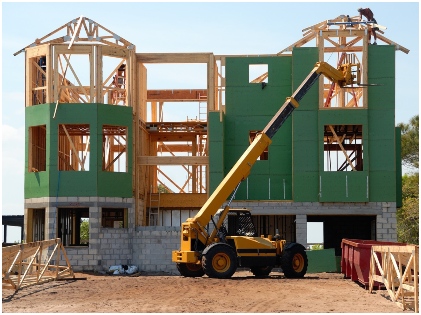
Here’s How Construction Loans Are Different From Traditional Mortgage

 If you want to finance your home construction, you will need a mortgage that’s quite different from the one when you buy an older or a new home. There are a host of things that you need to know when you are out to seek construction. So what are they?
If you want to finance your home construction, you will need a mortgage that’s quite different from the one when you buy an older or a new home. There are a host of things that you need to know when you are out to seek construction. So what are they?
First, you need to be aware of a construction loan and how these loans work. Next, you need to go through construction loans and different factors you have to consider regarding construction loans. Then comes how you can avail of a home construction loan and what are the ways of finding a construction loan lender. Without further ado, get on with it.
What Is A Home Construction Loan?
A home construction loan is essentially a short-term loan that has a higher interest attached. The loan finances the building of a residential property. The construction loans are generally for one year. Within this one year, you should build your property. You cannot cross this time limit. After the construction is over, they should issue a certificate of occupancy within that one year. You can use the loan to cover the land’s cost and pay for the building materials, contractor labor, permits, etc. It would help if you discussed everything in detail with the lender.
You have to be aware of what will be included in the calculation. Often, there will be a contingency reserve involved here. The contingency reserve will cover unexpected expenses that might crop during the construction. The reserve can also act as a buffer in cases where the borrower wants to upgrade anything. A construction loan doesn’t cover home furnishings and stuff. But, it might cover the costs of landscaping and appliances.
How Do These Loans Work?

Rates are variable in the case of construction loans. These rates tend to move up and down, say experts. As compared to the rates of a conventional mortgage loan, a construction loan rate is somewhat higher. Your home serves as the collateral for mortgage loans. In case you fail to make payments, the lender will eventually seize your home. The lender doesn’t have the authority to do so when you avail of a construction loan. Therefore, it’s normal for them to consider construction loans as risky.
You only have one year in your hand to repay a construction loan. These loans depend on the completion of your home. Therefore, you would have to state a construction timeline and let the lender know. Alongside, it would help if you also made the lender aware of the budget and all the plans in detail. Once you get loan approval, you will be on a schedule and track all the construction stages.
Different Kinds Of Construction Loans

Discussing the different types of construction loans, first, you have the construction-to-permanent loans. These loans offer you the money you need to build your nest and serve your permanent mortgage. In a nutshell, you take a loan to pay for the expenses you incur while building a home. Once you are done with the construction and are ready to move in, the construction-to-permanent loan will become a permanent mortgage.
For construction-only loans, the funds are offered based on the percentage of completion of your home. A renovation loan comes in handy when you wish to upgrade your nest, rather than construct a new home. You cannot disclose how you are using the money to the lender. As for the owner-builder construction loan, most lenders don’t give the borrower the authority to work as the builder of the home. There are some complexities involved.
What Are The Eligibility Requirements?
To avail of a home construction loan, you will have a fantastic credit score. A good one will also suffice. Next, you have to have a stable income. Any instability will disqualify you. You should make a down payment of around 20% of the entire amount you are borrowing as your loan. Last but not least, you need a low debt-to-income ratio to qualify for a construction loan.
If you face difficulties finding someone willing to lend you a construction loan, you can talk with credit unions or regional banks. However, before you go for any of these loans, make sure you read the fine print. This will avoid numerous financial troubles in the future.
More in Loans & Mortgages
-
`
Why Mortgage Demand Is Crashing as Interest Rates Skyrocket
Imagine having a favorite local ice cream shop that suddenly jacked up its prices by 50%. You would probably think twice...
November 18, 2023 -
`
Santo Spirits | Sammy Hagar and Guy Fieri’s Joint Venture
In the world of entrepreneurial partnerships, some unions are destined for greatness. The unexpected alliance between Sammy Hagar, the iconic Van...
November 12, 2023 -
`
Branded Content: A Genuine Way to Connect With Your Audience
Have you ever binge-watched a series on Netflix, only to later realize that the beverage everyone’s sipping on is that brand...
November 3, 2023 -
`
Southwest Airlines Tackles Passenger and Labor Challenges
Southwest Airlines, a prominent player in the aviation industry, has found itself at a crossroads, facing a combination of passenger dissatisfaction...
October 28, 2023 -
`
Everything You Need to Know About Blended Interest Rates
Hou ever blended a smoothie and thought, “How on Earth do my strawberries, spinach, and protein powder come together to taste...
October 17, 2023 -
`
The Osbournes ‘Relaunch’ Podcast After 5 Year Break
If you were glued to your TV in the early 2000s, there is no way you missed the hilarious, raucous, and...
October 10, 2023 -
`
Tesla in China: Back-to-Back Price Drops, But No Sales Jump?
As temperatures soared in the summer of 2023, Tesla seemed to be heating things up in the Chinese market too. A...
October 6, 2023 -
`
Navigating Red Flags in the Workplace
In the journey of our careers, it’s not uncommon to encounter red flags in our jobs that signal potential issues or...
September 30, 2023 -
`
Top 6 Best Housing Options for Older Adults
As we grow old, our physical and mental health needs change. In turn, this means that we require more assistance from...
September 21, 2023















You must be logged in to post a comment Login